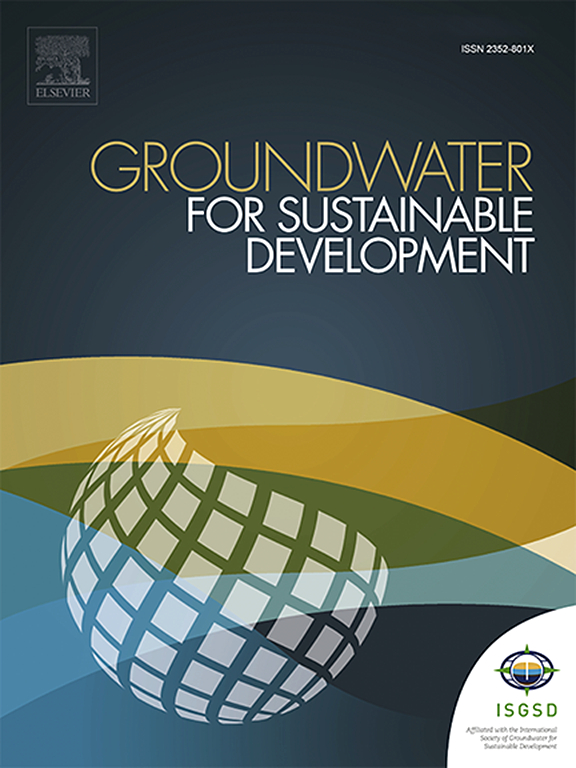Implications of multi-decadal land use changes on groundwater regime in tropical coastal regions
IF 4.9
Q2 ENGINEERING, ENVIRONMENTAL
引用次数: 0
Abstract
The present study investigates Odisha's coastal regions, analyzing Land Use and Land Cover (LULC) changes from 2009 to 2023 and their impact on land surface temperature (LST) and groundwater quality index (GWI) under increasing anthropogenic pressures. The findings revealed a 6.6% rise in built-up areas, a 25.6% increase in agricultural land, and a 4.2% decline in vegetation, with Kappa accuracies exceeding 80%. These changes corresponded to a 1.5 °C rise in mean LST. Hydrogeochemical analysis of 257 groundwater samples from Scenario 1 (2016–2017) and Scenario 2 (2022–2023) showed significant changes in water chemistry. Piper and Chadha diagrams indicated a transition from Na⁺-Cl⁻ to mixed Ca2⁺-Mg2⁺-Cl⁻ and Ca2+-Mg2⁺-HCO₃⁻ facies, reflecting a shift from saline to mixed water types and freshwater recharge. Despite this trend, scatter plots and molar ratios identified multiple contamination sources, particularly from anthropogenic activities. The GWI revealed that approximately 50% of the region falls into “poor” to “unsuitable” categories for drinking water, attributed to high levels of K⁺, Na⁺, and Cl⁻ in Scenario 1 and K⁺, HCO₃⁻, Na⁺, pH, and TH in Scenario 2, supported by ANOVA analysis. The increasing strong correlation between K+ and GWI further confirms the rise in agricultural activity. Gibbs diagram highlights rock-water interaction as the primary factor, with evaporation as secondary. The Ca2⁺ vs. SO₄2⁻ scatter plot highlighted carbonate weathering, contributing to increased groundwater hardness. TDS vs. TH correlation (>0.77) indicated worsening groundwater quality, with more samples transitioning to "very hard" and "brackish" categories. In contrast, strong correlations between TDS and Na⁺, Cl⁻ (>0.8) further confirmed increased salinity. Principal Component Analysis (PCA) revealed positive GWI and negative LULC loadings, linking urbanization and agricultural expansion to groundwater quality degradation. This study proposes sustainable water management (SDGs) strategies to fulfill SDGs 3, 6, and 11 enhancing coastal water resilience and public health.

热带沿海地区多年土地利用变化对地下水状况的影响
以印度奥里萨邦沿海地区为研究对象,分析了2009 - 2023年土地利用和土地覆盖(LULC)在人为压力下的变化及其对地表温度(LST)和地下水质量指数(GWI)的影响。研究结果显示,建成区增加6.6%,农业用地增加25.6%,植被减少4.2%,Kappa精度超过80%。这些变化对应于平均地表温度升高1.5°C。对情景1(2016-2017年)和情景2(2022-2023年)257份地下水样品的水文地球化学分析表明,水化学发生了显著变化。Piper和Chadha图显示了从Na + -Cl⁻到混合Ca2+-Mg2 + -Cl⁻和Ca2+-Mg2 + -HCO₃⁻相的转变,反映了从盐水到混合水类型和淡水补给的转变。尽管有这种趋势,散点图和摩尔比确定了多种污染源,特别是来自人为活动的污染源。GWI显示,该地区大约50%的地区属于“贫穷”或“不适合”的饮用水类别,原因是场景1中K +、Na +和Cl⁻的含量很高,场景2中K +、HCO₃⁻、Na +、pH +和TH的含量很高,方差分析支持了这一结果。K+与GWI之间日益增强的相关性进一步证实了农业活动的增加。吉布斯图强调岩石-水相互作用是主要因素,蒸发是次要因素。Ca2 +和SO₄2的分布图强调了碳酸盐的风化作用,增加了地下水的硬度。TDS与TH的相关性(>0.77)表明地下水质量恶化,更多的样本过渡到“非常硬”和“半咸”类别。相比之下,TDS和Na⁺、Cl⁻(>0.8)之间的强相关性进一步证实了盐度的增加。主成分分析(PCA)显示GWI为正,LULC为负,将城市化和农业扩张与地下水质量退化联系起来。本研究提出了可持续水管理(sdg)战略,以实现可持续发展目标3、6和11,增强沿海水复原力和公共卫生。
本文章由计算机程序翻译,如有差异,请以英文原文为准。
求助全文
约1分钟内获得全文
求助全文
来源期刊

Groundwater for Sustainable Development
Social Sciences-Geography, Planning and Development
CiteScore
11.50
自引率
10.20%
发文量
152
期刊介绍:
Groundwater for Sustainable Development is directed to different stakeholders and professionals, including government and non-governmental organizations, international funding agencies, universities, public water institutions, public health and other public/private sector professionals, and other relevant institutions. It is aimed at professionals, academics and students in the fields of disciplines such as: groundwater and its connection to surface hydrology and environment, soil sciences, engineering, ecology, microbiology, atmospheric sciences, analytical chemistry, hydro-engineering, water technology, environmental ethics, economics, public health, policy, as well as social sciences, legal disciplines, or any other area connected with water issues. The objectives of this journal are to facilitate: • The improvement of effective and sustainable management of water resources across the globe. • The improvement of human access to groundwater resources in adequate quantity and good quality. • The meeting of the increasing demand for drinking and irrigation water needed for food security to contribute to a social and economically sound human development. • The creation of a global inter- and multidisciplinary platform and forum to improve our understanding of groundwater resources and to advocate their effective and sustainable management and protection against contamination. • Interdisciplinary information exchange and to stimulate scientific research in the fields of groundwater related sciences and social and health sciences required to achieve the United Nations Millennium Development Goals for sustainable development.
 求助内容:
求助内容: 应助结果提醒方式:
应助结果提醒方式:


